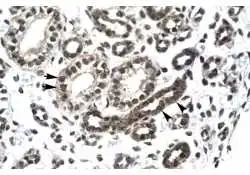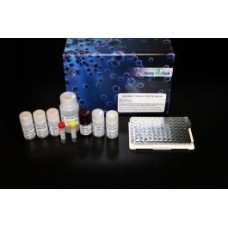PTHLH antibody [N1C3]
GTX100762
ApplicationsImmunoFluorescence, Western Blot, ImmunoCytoChemistry, ImmunoHistoChemistry, ImmunoHistoChemistry Paraffin
Product group Antibodies
TargetPTHLH
Overview
- SupplierGeneTex
- Product NamePTHLH antibody [N1C3]
- Delivery Days Customer9
- Application Supplier NoteWB: 1:500-1:3000. ICC/IF: 1:100-1:1000. IHC-P: 1:100-1:1000. *Optimal dilutions/concentrations should be determined by the researcher.Not tested in other applications.
- ApplicationsImmunoFluorescence, Western Blot, ImmunoCytoChemistry, ImmunoHistoChemistry, ImmunoHistoChemistry Paraffin
- CertificationResearch Use Only
- ClonalityPolyclonal
- Concentration0.88 mg/ml
- ConjugateUnconjugated
- Gene ID5744
- Target namePTHLH
- Target descriptionparathyroid hormone like hormone
- Target synonymsBDE2, HHM, PLP, PTHR, PTHRP, parathyroid hormone-related protein, PTH-rP, PTH-related protein, osteostatin, parathyroid hormone-like hormone preproprotein, parathyroid hormone-like related protein
- HostRabbit
- IsotypeIgG
- Protein IDP12272
- Protein NameParathyroid hormone-related protein
- Scientific DescriptionThe protein encoded by this gene is a member of the parathyroid hormone family. This hormone regulates endochondral bone development and epithelial-mesenchymal interactions during the formation of the mammary glands and teeth. This hormone is involved in lactation possibly by regulating the mobilization and transfer of calcium to the milk. The receptor of this hormone, PTHR1, is responsible for most cases of humoral hypercalcemia of malignancy. Four alternatively spliced transcript variants encoding two distinct isoforms have been observed. There is also evidence for alternative translation initiation from non-AUG (CUG and GUG) start sites, in-frame and downstream of the initiator AUG codon, to give rise to nuclear forms of this hormone. [provided by RefSeq]
- Storage Instruction-20°C or -80°C,2°C to 8°C
- UNSPSC12352203
References
- Chang WM, Lin YF, Su CY, et al. Parathyroid Hormone-Like Hormone is a Poor Prognosis Marker of Head and Neck Cancer and Promotes Cell Growth via RUNX2 Regulation. Sci Rep. 2017,7:41131. doi: 10.1038/srep41131Read this paper







